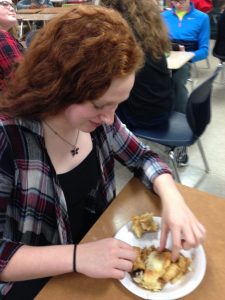Reading About “The Nose”
Today we read a very challenging piece of nonfiction text. “Magical Realism in the Tales of Nikolai Gogol” by James D. Hardy, Jr. and Leonard Stanton of Louisiana State University has some very interesting things to say about the distinctions of magical realism in “The Nose.” This provided us with a wonderful opportunity to review a piece of literary criticism about the story we have just read and dig deeper into the whole idea of our unit focus on magical realism. While the vocabulary of the text was challenging, each class period worked through it and practiced annotating. The honors classes also practiced summarizing claims in each of the four sections of text.
In summary, we revealed that the authors of “Magical Realism in the Tales of Nikolai Gogol” believe that the story “therefore, exists on three interlocking and circular levels of magical realism” (1).
We identified those three levels as:
- “the inherently surreal quality of daily life in St. Petersburg” In other words St. Petersburg, Russia was like not other place during the the time.
- “the appearance of the everyday can be regarded as not only the narrative consequence of the magical moment, but also its cause.” Meaning that ordinary everyday situations drive the story and are actually the cause of the magical or fantastical.
- “The inexplicable is an event that occurs suddenly and surprisingly, while realistic consequences play out as a narrative” It is the unexplainable events of the nose taking on a persona of it’s own that happens without explanation that drives the realism of the story.
Therefore, we learn from this text that Gogol inverted or changed the order of events used in most magical realism. Whereas magical realism is most often text in which “a supernatural or inexplicable event gives rise to a series of realistic consequences” “The Nose” does just the opposite because “the realistic detail of life in St. Petersburg could be satisfactorily explained only by reference to fantastic and surreal stories.”
Wow, what a deep concept. Can you wrap your mind around all those twists and turns? Sometime reading and understanding what someone else has said about a piece of literature can be much more difficult that reading the original literature and forming your own thoughts. Well, don’t worry you will get a chance to do quite a bit of your own literary analysis and criticism during your high school and college educational careers. One of the important things to look at in this particular text from today’s class is how the authors used lots of examples directly from the story as evidence to support the points they made. More on that to come next week.
